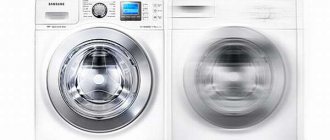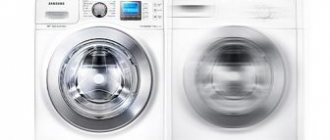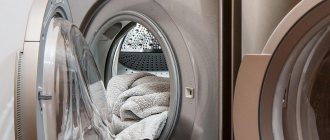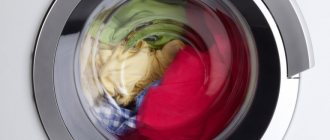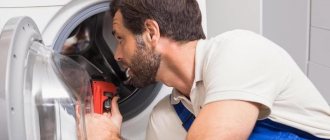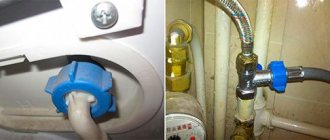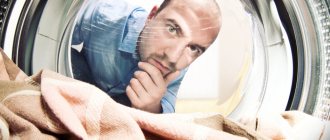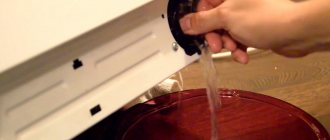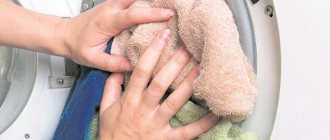- home
- Articles
- Washing machine creaks
A squeaking sound in your washing machine is always a sign of a problem.
If newly purchased and installed equipment is noisy, it must be returned, replaced or repaired under warranty. There should be no extraneous sounds when the new unit is operating. But if the machine begins to creak after several years of proper washing, this is a reason to contact washing machine repair. Creaking is heard due to the friction of parts or other things against each other. There are two main reasons why a washing machine squeaks:
- the fastenings that hold certain elements of the device are worn out and weakened;
- foreign objects have gotten inside the equipment and interfere with the work process.
To diagnose and eliminate the causes of the squeak, in most cases you have to call a specialist. He removes the cover or wall of the device and examines the inside to find the source of the noise. Usually it is possible to quickly find the cause, tighten loose fasteners or replace a worn part. Such repairs of washing machines allow you to extend the service life for several years and avoid having to buy new equipment.
Equipment may make sounds - this is normal.
It is worth understanding that a washing machine, like any unit, still creates some sounds during operation. In particular, you may hear:
- the sound of water pouring as it is drawn;
- the noise of a running drain pump (pump) when draining water;
- the sound of the engine when the drum rotates;
- drum noise at high speeds during spinning;
- clicks if the machine switches modes, for example, moves from the washing phase to rinsing mode, etc.;
- the noise of water heating, like in a kettle, during the washing process.
Don't worry, these sounds are not a malfunction.
Foreign object entry
During washing, a knocking sound is sometimes heard due to the presence of some foreign object in the tank. These could be keys, coins, buttons, rhinestones, or a bra wire. They can even pierce the tank at high speeds, so the device will jam and water will leak onto the floor. After removing foreign objects, it is necessary to check the parts for integrity and serviceability.
If you act incorrectly and connect the device to the system incorrectly, important parts of the washing machine will fail. Therefore, it is better not to carry out independent repairs, but to entrust the matter to a specialist.
Washing machine noise level in decibels
It is indicated in the characteristics of the machine and may differ slightly depending on the brand and model of the equipment. In most modern washing machines, the permissible noise level does not exceed 55 dB (decibels) during washing and 70 dB during spinning.
What is 50-55 dB? This is loud human speech or background music. The noise level is 80 dB - the noise of a large highway. Thus, there is no need to talk about the machines being completely silent. But if you close the door to the room where such a machine is working, the sounds really won’t bother you.
The washing machine is noisy due to improper use
Overloading, underloading or uneven distribution of things in the SMA can lead to loud noise during the spin cycle. Be careful to read the washing machine instructions and follow the rules regarding the weight and size of the laundry you load. This will not only save you from increased noise, but will also extend the life of the equipment.
Note! Underloading the washing machine or washing one large and one small item is no less dangerous than overloading it. Since in these cases the washer cannot distribute the load evenly throughout the drum, it “dangles” during the spin cycle more than necessary and creates loud sounds.
Why is there an unpleasant sound when spinning?
If the washing machine squeaks during the spin cycle, the reasons may include factors such as:
- Drum imbalance. It is a consequence of the weakening of the drum shaft, which causes free movement during spinning. In this case, the drum begins to wobble in different directions at high speeds, friction occurs with various parts (cuff, oil seals, etc.) and, as a result, creaking occurs. To fix the problem, you need to adjust the drum shaft mount.
- A foreign object has gotten between the tank and the body. This problem often occurs in top-loading machines. Small laundry or foreign objects may jump out of the drum and create friction at high speeds. The foreign object must be removed, otherwise it may cause the drum to jam and cause more serious damage.
- Failure to secure parts. In machines of poor quality, the mounting bolts may weaken over time and cause squeaking during spinning. In such a situation, a thorough diagnosis should be carried out and all fasteners in the household appliance should be adjusted.
Another reason for the squeaking of any top-loading washing machine can be the failure of the shaft bearings. Parts need to be replaced urgently. Otherwise, this may lead to additional violations of the integrity of other parts.
Top loading washing machine
If a squeak occurs at any stage of washing, it is important to carry out diagnostics as soon as possible, establish the cause and eliminate it. Otherwise, the breakdown may worsen and completely damage the washing machine. It is best to contact a service center or call a qualified technician for repairs.
Manifestations of unnatural noise
The quiet measured noise of a moving drum and a running motor occurs during washing in any model of machine such as a centrifuge. First, you should pay attention to the nature of the sound, which may indicate a malfunction:
- the sound is unnatural, it increases with each wash;
- The washing machine is especially noisy during the spin cycle;
- pronounced extraneous noise, similar to clanging, grinding or hitting.
Of course, the first thing that might come to the owner’s mind when faced with such a common phenomenon in a washing machine is that it’s just a sound due to the metal parts of the clothes themselves. But when you wash bed linen or towels, and the noise gets louder, it’s time to think about a malfunction.
Why is the sound of the washing machine heard most during the spin cycle? The fact is that at this stage of operation the centrifuge drum rotates the strongest and fastest.
This serves as a good test for all mechanisms. Accordingly, with the increase in the roar of the engine, noise during breakdowns will be more noticeable, since rapid movement rocks all other parts, including the body.
Main reasons
There are several reasons why the drum in a washing machine knocks during the spin cycle. This may indicate that:
- laundry in the centrifuge is distributed unevenly;
- a foreign object got inside;
- the machine is installed incorrectly;
- the spring mechanism has failed;
- the counterweight is broken;
- bearings are worn out;
- The power filter has come off.
You need to take certain actions depending on the cause of the knocking.
This problem is typical for older machines. In them, when washing and spinning, things do not straighten out, but clump together. In order for the centrifuge to stop knocking, when loading laundry, you need to lay it out evenly, without overloading the drum. It is also advisable to wash bedding and clothing separately.
Sometimes, when operating the machine, small objects fall out through the holes in the centrifuge into the space between it and the outer tank, for example, a bra wire, a button, or a small item that might have fallen out of your pockets. In this case, in order to remove a foreign object, if it cannot be reached through the door cuff, the device will have to be disassembled.
If errors were made during the installation of equipment, then in accelerated operation this is especially noticeable. In this case, it is necessary to check the correct location of the unit and make the necessary adjustments. In order to determine whether the car is level, you can use a level. If distortions are detected, it can be moved to a more even surface. In some models, the position can also be adjusted using screw-in and screw-out legs.
Shaft weakening
After a long period of use or due to poor assembly of the washing machine, the shaft mounting bolts may become loose, which upsets the balance of the drum; it begins to rattle and squeak. This problem can be easily resolved: you just need to tighten the bolts. However, the design of the machine does not always make it easy to reach them. If you cannot do this yourself, it is better to turn to professionals so as not to accidentally damage other structural elements.
Drive belt stretched
The belt that spins the drum can stretch over time and slip, making whistling sounds. If the reason is the belt, the creaking will be especially audible when the machine is heavily loaded and during a high-speed spin. At the first sign of belt stretching, it should be replaced or simply tightened. Otherwise, it may tear during operation, which in turn can lead to other, more serious damage.
Creaking at body joints
The fastenings of the machine body can also become loose and creak over time or due to poor quality assembly. It will not be superfluous to tighten all the bolts connecting the parts of the body and inspect all connections and fastenings that could become loose.
If all these simple manipulations do not help you solve the problem of your washing machine grinding, contact qualified technicians for diagnostics and repairs.
The fastenings of the structural elements of the washing machine are loose
If the noise level in the washing machine increases at high speeds and is accompanied by rumble, creaking and increased vibration, this may indicate a breakdown of the fastening elements.
Malfunction of bearings and seal
At first, a quiet extraneous sound will appear during washing, spinning, even when manually turning the drum. Over time, the sound will intensify, and a strong buzzing sound can be heard during the spin cycle. Rust streaks are visible under the CM on the tank. The laundry does not wring well, it is covered in stains from oil and rust.
Why is this happening? Over time, the seal becomes less airtight, water appears in the bearings, the lubricant is washed off and the balls in the bearings become rusty and destroyed. As the deformation progresses, the grinding noise of the rotating drum will intensify. Water will also start to drip through the bearings at the back of the drum. If water gets on a running motor, it will cause a short circuit and knock out the machine, causing the motor to smoke.
If you do not change the bearing and oil seal when these symptoms occur, the crosspiece, caliper and tank will become damaged over time and it will be much more expensive to repair the washing machine. In LG models with direct drive, drum play will damage the Hall sensor, so you need to urgently call a specialist.
Stages of the technician’s work when replacing a bearing:
- Unscrew and remove all bolts on the rear panel.
- Removing the dispenser.
- Removing the control unit.
- Removing blocking.
- Removing the remaining fixing parts, removing the front panel.
- Loosening the clamp.
- Dismantling the counterweight and tubular electric heater.
- Disconnecting all cables, pipes, and belts from the tank.
- Dismantling the motor, after which the tank and drum are removed.
- The cuff (rubber seal) is removed.
- The tank is installed so that the pulley is accessible, the bolts securing the pulley are unscrewed, which is also dismantled.
- The shaft is knocked out, after which the bolts connecting the two parts of the tank are unscrewed, which are also separated.
- Old grease and dirt adhering to the bearing are removed.
- The bearing is knocked out, the seals are removed.
- The space is wiped and lubricated with lubricant.
- New seals with bearings are installed.
When the work is completed, the specialist will assemble the structure in the reverse order. Carrying out this procedure on your own without special tools and proper skills is very problematic.
Retaining springs squeak
The springs that fix the position of the tank may well be the source of the whistle. The rods can rub against the mounting sockets and make a very unpleasant whistle. Finding out whether this is actually the reason is quite simple: you need to remove the upper part of the washing machine body. Start the washing program and during operation (when a squeak appears) press firmly on the seat.
If the squeak disappears, then the problem is in the rods and springs. To eliminate the malfunction, it is necessary to lubricate the contact points with ordinary machine oil.
How to understand the cause of a strange sound in a washing machine
If the washing machine squeaks when the drum rotates, the most common cause may be a clogged cuff. Small pieces of laundry or other large debris could get here. In this case, you need to carefully bend the rubber seal and clean it around the perimeter. If after cleaning the unpleasant sound remains, the reason lies much deeper, and you need to call a qualified specialist.
Place of cuff blockage
How to properly diagnose a machine
In order to identify a malfunction in a timely manner, you need to familiarize yourself with the features of diagnosing the washing machine.
This is done after familiarizing yourself with the main reasons for the appearance of extraneous sounds during spinning.
During the diagnostic process, you will have to check how level the structure is installed. You will also have to disassemble it to check the serviceability of the parts and make sure that there is no debris or other large objects inside the drum that could knock.
What can cause grinding noise in a washing machine?
For an accurate diagnosis, it is necessary to disassemble the unit, remove the cover and side parts, and carry out a detailed diagnosis. Each washing machine manufacturer has certain weaknesses that can cause an unpleasant grinding noise. For example, in Indesit technology, springs and shock absorbers often fail. This is the reason why the drum in the washing machine squeaks.
Depending on at what stage of washing the machine makes a grinding noise, you can judge the nature of the breakdown.
Laundry loading stage
Checking the drain filter
In popular brands of washing machines, such as LG or Ariston, this part is located in the lower right corner behind a small panel held in place by latches. You can remove it with your hands or help yourself with a screwdriver to press the latches. Now follow the instructions:
- Use a rag or low container to catch the water that comes out of the filter.
- Turn the filter cap counterclockwise.
- Take out the filter and inspect it.
- Remove visible blockages with your hands, then rinse the part under the tap.
- Place the element in place, screwing it tightly.
- Run a test wash and see if the hum and noise are gone.
Take note! If the filter cannot be unscrewed due to severe blockage, then the only way to get it out is from the inside, not the outside. In this case, the filter is taken out along with the pump.
If the filter is clean and no significant debris is found in it, then check the drain hose and pump further. Inspecting them inevitably requires disassembling the washing machine body. The pump is removed differently in different brands of cars.
- So, “Whirlpool”, “Samsung”, “Elgie”, “Ardo”, “Indesit” and “Ariston” do not have a bottom cover, so it is enough to put the SMA on its side to get to the pump.
- If you are the owner of a Bosch, Siemens or AEG machine, then you can only reach the pump from the front.
- In the Zanussi and Electrolux SMs, the pump is removed through the rear wall of the housing.
Manufacturers usually provide entire instructions in the user manual. But if the manual is lost without a trace, our photo instructions in the article “How to clean the pump in a washing machine” will come to your aid.
After you clean the pump, replace it or replace it with a new one if cleaning does not help. If the pump is still noisy after this, check other parts.
Checking the pipe and hose
If the filter and pump are in perfect order, and noise and hum still accompanies every wash, then the drain hose and pipe are likely to be clogged or broken. Having disassembled the SM body, you need to remove the clamp holding the pump and hose (disconnect the other end of the hose from the sewer).
Remove the hose from the washer and rinse under the tap using a cable with a brush at the end. After cleaning the hose, install it in place and check the operation of the machine.
If this does not help, carefully pull off the drain pipe - it may be clogged, which is where the noise comes from. Even though the rubber pipes are wide in diameter, debris can still accumulate in them, so pay attention to cleaning the pipe. At the same time, inspect it for damage and leaks so you can quickly replace the part.
If you have done everything we suggested and the car still makes noise, you should contact a specialist.
Minor faults
Some washing machine models may squeak during washing. This is how the equipment sends signals about a breakdown of the display unit. On most of them, a warning about a program error appears in the panel. This does not affect the quality of washing, but it does significantly affect the choice of programs.
If the machine hums while draining, then it is worth checking whether it is draining water. Quite common reasons:
- Drain pump clogged or broken.
- The drain hose is clogged.
- The drain hose is kinked.
- The filter is clogged.
Cleaning the drain filter.
First you need to check the filter and drain pump. To do this, you need to unscrew the small door, pull out the filter, and clean it of accumulated debris. Free the pump blades from foreign objects. Before starting work, it is worth covering a piece of fabric, because water will flow out of the hole. After cleaning, all elements must be replaced.
Modern machines themselves tell you what is wrong and display an error code on the screen. But this does not mean that you need to do the repairs yourself. This will require certain knowledge and skills. Disassembling the machine on the kitchen table using available tools will not always help to fix it. This can only complicate the work of the master. Therefore, if you are not confident in your abilities, it is better to entrust the assistant to a professional.
Preventing blockages so that the pump does not make noise
To prevent unnecessary noise from occurring due to foreign objects, prevention is needed. You don’t have to do anything supernatural, just follow the basic rules for using the machine:
- soften water with special means;
- clean SMA parts from scale;
- Clean the filter after every 5th wash (or at least once a month);
- sort clothes, check pockets.
We hope you now know what to do to stop your washing machine from making noise anymore. If you still have questions, you will find comprehensive answers to them in the video:
When the knocking is not associated with a breakdown
Sometimes the sound does not come from inside the washer. The cause of noise is in the environment or external elements of the SMA.
- The machine is close to furniture or a wall. According to the installation rules, there must be a gap between the case and adjacent objects if the equipment is not built-in. When everything is standing end to end, due to vibration, the SMA can knock on the surface nearby. Move the equipment aside or place a shock absorber between the body and the wall. For example, a rubber or foam seal with an adhesive backing.
- The washing machine hose is knocking . Another source of sound is the drain hose. If it is poorly secured and loose, it can knock on the body of the washer. Check the hose and secure it tightly to the body.
Sometimes it rattles inside the machine, but the reason is not in it, but in the laundry.
- Clothes fittings are knocking. There are metal or plastic parts on clothes: zippers, buttons, trim. Such items need to be turned inside out or placed in a washing bag in the machine so that the hard parts do not touch the drum and rattle. In addition to the fact that the fittings are noisy, they can damage the drum, the repair of which is expensive.
Have you checked how the machine is installed, secured the hose, did not wash items with hard fittings, but the knocking does not stop? This means it’s time to call a repairman; the cause of the suspicious sounds, unfortunately, is related to a breakdown.
Is it worth undertaking expensive repairs?
Replacing bearings belongs to the highest category of complexity, because to perform this operation you have to almost completely disassemble the washing machine. A set of bearings and seals does not cost much, but the services of a professional will be expensive, and only an experienced mechanic can do the replacement yourself. The cost of repairing a tank costs half the price of a new washing machine, so sometimes even the service center employees themselves advise owners to sell the old equipment for spare parts and buy a new one.
Buying a new washing machine will cost more than repairing an old one in many cases. If the equipment has worked for more than half of its designed service life and has long been removed from warranty, one breakdown will be followed by another. In addition, the likelihood of finding original spare parts decreases every year - manufacturers may discontinue the model. If you use cheap analogues from unknown companies, the result is unpredictable. It makes sense to repair equipment in cases where the damage is minor and the washing machine is still completely new.
Causes of noise when spinning a washing machine
If noise appears in the machine when the drum rotates, it is necessary to determine the cause of its occurrence. The machine is designed quite simply, but here are a number of reasons why noise occurs:
- Presence of small objects inside the machine.
- Bearing wear.
- Presence of unscrewed transport bolts. When moving and transporting a machine, many often forget to unscrew the bolts, thereby preventing the normal operation of the equipment.
- Breakage or loosening of the centrifuge rotation axis.
- Poorly secured counterweights.
- Drain pump failure.
- Incorrect installation of the machine. The washing machine is installed on an unsteady surface or is not level. These are some of the most common causes of noise.
Let's look at each of the reasons in more detail.
Incorrect installation of the washing machine
If during installation the machine was not placed level and it wobbles when pressed, you need to level it. At high speeds, the machine may begin to creak, and centrifugal force may create an imbalance; all this will sooner or later lead to breakdown of the washing machine. This may not be easy to do, but doing so will help avoid many problems in the future.
The problem is solved by installing the machine on a flat floor and leveling it exactly level. To do this, you will have to unscrew the legs of the machine so that it does not swing.
Breakage or loosening of the centrifuge rotation axis
The consequence of this malfunction may be clicking and vibration of the washing machine during spinning. This occurs due to the loosening of the pulley nut that secures it to the drum. When spinning, the pulley begins to dangle and hits the back wall of the machine, for this reason clicks may be heard.
To fix this problem, you need to tighten the pulley nut.
Transport bolts
If extraneous noise appears in the machine during the spin cycle, this may indicate that the transport bolts were not unscrewed when installing the washing machine. For the safe transportation of washing machines, manufacturers offer the use of special fasteners that secure the drum damping springs. If you do not unscrew them immediately, the machine may crack and rattle during the washing process.
To solve this problem, you need to remove the mounting bolts that are located on the back wall of the machine.
Foreign objects inside the machine
If the machine makes a loud noise during the spin cycle and begins to vibrate or a whistle is heard, it can be assumed that some small objects from clothing pockets have gotten into the drum. According to surveys of machine repair services, this reason is very common.
When putting things into the machine, you need to check the pockets every time, as there may be objects left there that can cause damage.
At low speeds, the washer creates virtually no vibration, so everything that gets into the drum settles at the bottom. But when the washing machine goes into spin mode, it begins to vibrate strongly and foreign objects begin to get stuck between the drum and the walls of the tank. A grinding noise appears, and machine parts can rattle and whistle, which ultimately leads to the washer breaking down.
To get out all the small things that are in the tank, you need to unscrew the heating element and, sticking your hand into the tank, pull out everything that is there.
Problems with counterweight
A knocking noise may be heard during the spin cycle. This indicates that the counterweights (usually a concrete block) are poorly attached. These parts are necessary to balance the tank and are bolted to its body. When the fastenings are loosened, the counterweights hit the tank. The machine hums loudly and sometimes jumps.
Such damage can be eliminated by tightening the counterweights. This is done by unscrewing the back wall or top cover of the machine and tightening the screws holding the balancers together. They must be tightened carefully. To access the screws, unscrew the cover of the machine. If the counterweight is cracked, it must be completely replaced.
Bearing wear
Bearings are one of the most important parts. After all, with their help the drum rotates. Noise when the drum rotates during washing and spinning indicates that it is in an unstable state.
When the wear of the bearings has just begun, the washing machine hums, rattles, and makes noise. Subsequently, the noise intensifies. If the bearings are not replaced, the device may break. The source of the problem can only be discovered when disassembling the machine.
You can diagnose the bearing yourself. To do this, open the door and press on the top edge of the drum. If you feel any movement up and down, you may suspect a malfunction. Then you need to spin the drum - extraneous sounds also indicate a malfunction.
The service life of the bearings is approximately 10 years. Their wear occurs either from corrosion or from wear of the oil seal. Also, the bearings wear out if an excessive amount of laundry is loaded into the machine.
The breakdown can be repaired in a workshop. Sometimes you can try to change the bearing yourself. Replacing a bearing is not as simple as it might seem. Sometimes you have to change the seal. In some cases, a plastic tank cannot be disassembled. If you do not have experience in replacing parts of an automatic machine yourself, it is best to take it to a service workshop.
Foreign objects and improper installation
If the washing machine starts knocking during washing for the first time, do not panic. You need to listen to the sound being made. The reasons for such “musical accompaniment” can be quite banal. Items of clothing that are currently being washed can knock and ring. You need to remember what things are in the washing machine:
- Large buttons or metal elements on clothing may knock on the hatch glass or drum;
- coins or keys spilled out of pockets that they forgot to take out before starting the wash.
How to reliably remove a squeak?
Masters have several methods in their arsenal to eliminate squeaking when the drum rotates. Not all of them can be called simple and safe. So, some advise loosening the clamps, removing the cuff and re-adjusting its position. However, it will be problematic for a housewife to do this at home. Firstly, the method is not suitable for all models of washing machines, and secondly, the process of dismantling and tightening the cuffs is a rather troublesome procedure. It is difficult to determine the correct position for the seal without experience.
The second option is even riskier. According to it, it is recommended to first remove the cuff and then trim the edges clinging to the drum with a stationery knife. But if an experienced craftsman can determine the place of friction and easily return the rubber to the hatch, then an ordinary user is more likely to ruin it by cutting it in the wrong place. But this does not mean that without service you cannot get rid of the sound of friction on rubber. There is a safe and relatively easy repair option. The instructions are as follows:
To remove the “catch”, you will have to spin the drum about 100-120 times. This will take time, but the risks of damage to the cuff and the machine itself are minimal. Afterwards, all that remains is to run the test cycle and listen: if the squeak disappears, then the problem is solved; if not, we repeat the procedure.
Prevention
In order for the machine to serve as long as possible, you should take small precautions:
- Items with small parts that can come off during washing are best washed in a special bag;
- Before placing things in the tank, you should check their pockets for debris, small items and other items that could damage the drum;
- do not exceed the load of the washing tank, observe the restrictions;
- add special substances that soften water - they will help preserve the heating element and remove scale;
- the machine must stand level and secure;
- It is advisable to ventilate the internal elements of the device, for which you need to open the hatch for loading laundry and the tray for detergents.
All these simple tips will help prolong the operation of your washing machine and protect you from contacting a technician or a repair and maintenance center, and, consequently, from unnecessary expenses.
Precautionary measures
In order for the machine to work for a long time, you must adhere to certain rules.
- You need to be vigilant and carefully inspect things for small parts that may come off during washing and get into the tank. It is better to put such things in a special laundry bag.
- Remove money and other small items from your pockets that could damage the machine during the washing process.
- Protect the heating element from scale that forms from hard running water. To do this, you need to use water softening and descaling products.
- It is necessary to move the washing machine at least once every six months and check the serviceability of the hoses, as well as flexible wiring and pipes for damage.
- Wash and clean the drawer for powder and rinse aid. If this is not done, hardened powder particles may accumulate in the machine, which will interfere with the normal operation of the equipment.
- After each wash, leave the powder container and the machine door open. This is necessary so that the internal parts of the washer dry thoroughly.
All these recommendations will help extend the life of the washing machine and protect it from frequent breakdowns and calls to service centers.
Some types of repairs can be carried out independently, but still, if the breakdown is serious, it is best to contact a service center and call a specialist to your home.
Solutions to the problem
After identifying faults, some of them can be fixed with your own hands, but for more complex ones you will need to disassemble the machine. How to fix the most common breakdowns?
If foreign objects get inside the machine, you will most likely have to disassemble it. To do this, you need to open the lid, remove the electric heating element and remove these things from the tank. In the event that it is impossible to reach foreign objects, you will have to completely remove the tank.
Replacing bearings is an inexpensive but rather complex repair. If they are not replaced, they may break the spider. To replace the bearings, the machine is completely disassembled and the tank is removed. The bearings are removed from their mounting points and replaced with new ones.
When repairing, it would be correct to replace all elastic parts. Before starting repairs, do not forget to buy a repair kit.
The transportation bolts must be removed before installing the machine in place - this will eliminate one of the causes of noise during operation.
Shock absorbers are not repaired, but replaced. To replace the dampers, you need to remove the rear cover of the car, unscrew the fasteners located below the shock absorber tank, remove them and install new ones. Then carry out all the steps in reverse order.
If the balance of the axle is disturbed, then it is necessary to tighten the nut on the pulley. In case of problems with the counterweight, it is necessary to remove the back or front panel (depending on the design of the device) and tighten all loose fasteners. If one of the weights breaks, and such cases are very rare, you need to replace it with a new one.
Leveling the machine is very easy. To do this, it must be installed on a flat floor, and by rotating the legs with a special key, we make sure that it does not swing.
Before you begin repairs, check whether you have the necessary set of tools, repair kits and spare parts. And do not forget to disconnect the repair facility from the power grid and water communications.
Damage to shock absorbers
Shock absorbers fix the tank in the washing machine from below, dampening vibrations during washing and spinning. The more often you use the equipment, the more you overload it, the faster the shock absorbers will fail. Even under ideal operating conditions, shock absorbers wear out: the lubricant dries out, the piston becomes loose and moves freely. Therefore, during the spin cycle, the tank will begin to dangle, the machine will jump around the bathtub, the intensity of vibrations will increase, and the drum will begin to knock.
It is necessary to change both shock absorbers, then the load will be distributed evenly. If you change only one, the new spare part will quickly break and the problem will recur.
In some washing machines, dampers (shock absorbers) are accessible from below, and in others from above. The specialist unscrews the bolts securing the shock absorbers to the body, disconnects them and replaces them with new ones.
- Remove the top cover of the machine by unscrewing the fixing fasteners on the back of the case and sliding the top panel.
- Remove the powder container and the lower plastic panel that covers the drain filter.
- Dismantles the control panel by unscrewing the fixing fasteners and disconnecting the cables.
- Remove the rubber cuff.
- Unscrew the bolts securing the front wall and remove it.
Once access to the shock absorbers is opened, the old spare parts are dismantled, new ones are installed, and the unit is assembled in the reverse order.
If you are not afraid to disassemble and repair equipment yourself, you can do it all yourself.
This is interesting: Do-it-yourself air conditioner repair: main faults and their elimination
Tips for avoiding malfunctions
- Observe the permissible load during washing - leave the drum one third empty.
- Perform preventative cleaning between work cycles.
- Try to use programs with high water heating as little as possible.
- Open the door after each wash to allow the machine to dry.
- If you wash several times a day, take breaks of 30 minutes.
- Leaving the washing machine idle for a long time causes the lubricant to evaporate and dry out.
- For budget models, components quickly wear out or wear out.
- Follow the rules for transportation, installation and connection to communications.
